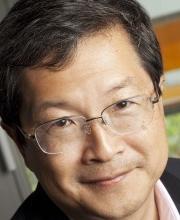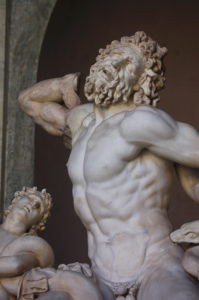by Shigehisa Kuriyama
The essay begins:
If you think about it, “No pain, no gain” is a very strange saying. It exhorts us actively to embrace what we ordinarily abhor and are desperate to avoid. Pain is arguably the barest, most primal experience of the bad; and yet “No pain, no gain!” enthusiastically lauds pain as a good to be actively pursued, promoting it even, as the sole source of the good. Which seems not only odd and paradoxical, but also almost willfully perverse—and makes us wonder how such a saying came to be so widely recited as common sense.
Bodybuilders in 1970s America were among its earliest champions. “No pain, no gain” became known as the motto of the celebrated muscleman Arnold Schwarzenegger and appeared regularly in advertisements, as the catchphrase, for example, of Soloflex weight training machines. But the saying soon spread beyond devotees of muscle sculpting and was adopted by countless other Americans aspiring just to be healthy and fit. For vast legions of joggers and exercise enthusiasts, the “No pain, no gain” motto voiced a diffuse but earnest faith in the need for a certain strenuousness. Any exercise worthy of the name, any truly effective workout, had to hurt a bit. “Feel the burn!” Jane Fonda urged the sweating and panting followers of her popular aerobics videos. “No pain, no gain!”
There were critics, to be sure. Although “No pain, no gain” was championed as a mantra of fitness, it had scarcely caught hold when it was denounced, intriguingly, by precisely those experts who knew the body best. Physicians called it a foolish misconception, “macho nonsense.” “Physical pain,” one doctor wrote, “is the body’s way of saying that what you are doing goes beyond its limits.” It was a message, nature’s warning against harm, and by ignoring pain aspirants to fitness actually risked serious injury.
Athletic trainers, too, were critical. “Learn to listen to the body,” one counseled:
The “no pain no gain” philosophy is wrong and suited only to masochists. If any activity causes pain, reduce the intensity of the workout or stop the activity altogether, at least for a while.
To ignore pain is foolish, to embrace it is a perversion. The belief that gain demanded pain, that one could enhance the body only by making it hurt, declared a trainer in 1986, was “the most damaging myth in athletics and fitness.” Articles debunking the myth were common, and “No pain, no gain” was cited far more often in condemnation than in praise.
And yet, the belief persisted—and still persists, as witnessed by the criticisms, which also persist. This is what is strangest. Although doctors and athletic trainers regularly attacked “No pain, no gain” as dangerous folly, their need to keep repeating their attacks bespoke the appeal and resilience of the idea. “No pain, no gain” is one of those primordial certainties that mere science cannot easily shake. The arguments against overexertion—the need to heed pain as a warning and the wisdom of moderation—all sound sensible and are backed by expert opinion. But they somehow fail to reach the roots of conviction. Somehow, the tie between pain and gain just feels true, despite the ostensible oddity of seeking the good in the bad, despite the risk of lasting bodily harm.
I want to excavate the archaeology of this deeply felt truth. Once a saying gains common currency, we often cease to reflect on how or why it became common, or even what it really means. Yet if ever there was a notion that called for serious reflection, it is surely the idea of good pain. Few of us would claim that all pain is good, and most of us would probably agree that most pain is bad. But the popularity of “No pain, no gain” suggests that there is a special kind of pain that is widely considered a definite and necessary good. I want to probe the nature of this exception, and trace the history of how and why this pain became special. Continue reading …
“No pain, no gain” exhorts us actively to embrace what we ordinarily abhor and are desperate to avoid. It promotes the idea of good pain. In this essay, cultural historian Shigehisa Kuriyama excavates the historical and metaphysical roots of the idea of good pain and situates the modern slogan in the context of a profound change in the experience of presence.
 SHIGEHISA KURIYAMA is Reischauer Institute Professor of Cultural History at Harvard University. His book The Expressiveness of the Body and the Divergence of Greek and Chinese Medicine (1999) received the 2001 William H. Welch Medal of the American Association for the History of Medicine. His recent work includes studies on the history of distraction, the happiness of happenings, the transformation of money into a palpable humor, hiddenness in traditional Chinese medicine, and the web of connections binding ginseng, opium, tea, silver, and MSG.
SHIGEHISA KURIYAMA is Reischauer Institute Professor of Cultural History at Harvard University. His book The Expressiveness of the Body and the Divergence of Greek and Chinese Medicine (1999) received the 2001 William H. Welch Medal of the American Association for the History of Medicine. His recent work includes studies on the history of distraction, the happiness of happenings, the transformation of money into a palpable humor, hiddenness in traditional Chinese medicine, and the web of connections binding ginseng, opium, tea, silver, and MSG.


 SHIGEHISA KURIYAMA
SHIGEHISA KURIYAMA Trying to understand pain tolerances as a symptom of culture already gets us entangled in a second distinction: that between pain experiences and pain expressions. Here we enter upon a field of investigation in which the historian of art feels right at home, since questions surrounding the representation of pain in the visual arts have always been part and parcel of imitative art’s charge to represent psychic states and moral virtues—or their opposites—through coded bodily movements, gestures, and physiognomic signs. But questions of pathetic naturalism only get us so far in explaining why, for example, the famous clenched brow of the Trojan priest Laocoön in the eponymous figure group in Rome, as a physiognomic token of pain, communicated to its beholders a “pain-experience” so different from the one conveyed by its counterpart in the Master of Flémalle’s image of a Crucified Thief. We could rehearse the clichéd contrast between heroic death in pagan tragedy and sacrificial suffering in Christian theology to see that distinct narratives of human suffering and conflict are what drive the transferences between pain experiences, pain representations, and pain perceptions. Would we find that it is the very possibility of narrative that makes pain culturally intelligible in the first place? What’s clear is that the full implications of a culture’s narrative-ideological meanings for pain expression in the visual arts would be lost if we failed to attend to the situated functions of images, the peculiar agency they are granted to enlist the beholder’s effort in realizing their effects and completing their meanings in historically specific situations of use. Something of the logic of that agency can be recovered and measured by the forms of response demanded and structured by the image. We may begin, then, with one kind of image that, in portraying the very response it demands, tells us something about the peculiar way spectacular pain expressions registered in late medieval culture.
Trying to understand pain tolerances as a symptom of culture already gets us entangled in a second distinction: that between pain experiences and pain expressions. Here we enter upon a field of investigation in which the historian of art feels right at home, since questions surrounding the representation of pain in the visual arts have always been part and parcel of imitative art’s charge to represent psychic states and moral virtues—or their opposites—through coded bodily movements, gestures, and physiognomic signs. But questions of pathetic naturalism only get us so far in explaining why, for example, the famous clenched brow of the Trojan priest Laocoön in the eponymous figure group in Rome, as a physiognomic token of pain, communicated to its beholders a “pain-experience” so different from the one conveyed by its counterpart in the Master of Flémalle’s image of a Crucified Thief. We could rehearse the clichéd contrast between heroic death in pagan tragedy and sacrificial suffering in Christian theology to see that distinct narratives of human suffering and conflict are what drive the transferences between pain experiences, pain representations, and pain perceptions. Would we find that it is the very possibility of narrative that makes pain culturally intelligible in the first place? What’s clear is that the full implications of a culture’s narrative-ideological meanings for pain expression in the visual arts would be lost if we failed to attend to the situated functions of images, the peculiar agency they are granted to enlist the beholder’s effort in realizing their effects and completing their meanings in historically specific situations of use. Something of the logic of that agency can be recovered and measured by the forms of response demanded and structured by the image. We may begin, then, with one kind of image that, in portraying the very response it demands, tells us something about the peculiar way spectacular pain expressions registered in late medieval culture. 